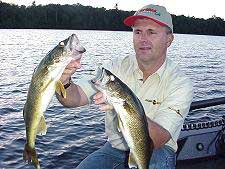 Scenario: Warm, misty overcast evening in August. Mid lake rock humps topping out in the 16 to 22 foot range. Scenario: Warm, misty overcast evening in August. Mid lake rock humps topping out in the 16 to 22 foot range.
Usually, by late August many walleyes in deep clear lakes begin to leave their summer home ranges,suspended over deep open water, and migrate onto nearby rock and gravel humps. More often than not, the best humps top off at a range near the lake’s thermocline. For example, if a lake typically thermoclines at 22 feet, humps in the 18 to 22 foot range are most apt to hold fish, while shallower cropping structures will be less productive.
When these mid lake humps are small, one can usually do quite well jig fishing them, but more so these humps tend to be large. This is when board trolling a spread of crawler harnessed spinner rigs anchored to bottom bouncing weights off planer boards is the key way to catch them. This is precisely the situation Joe is faced with in this segment. The mid lake rock/gravel structure is very large with a number of smaller “spines” topping out in the 14 to 18 foot range; however, most of the rock/gravel structure is much deeper at 22 to 26 feet.
The small spines are holding the fish, but they are somewhat difficult to stay on top of and pinpoint precisely in open water. This problem is easily solved by repeated trolling passes using this board/bottom bouncer/crawler harness system. Trolling ever so slowly, once any bottom contact is made, you can literally drag an armada of tempting tidbits across these spots and find these small groups of walleyes that are utilizing these spines.
The rigging trick here is to set out just enough line below the planer board so it will catch, or better termed “tick”, the top of these spines, yet not get hung up. The best way to accomplish this is by staying as vertical as possible with your set up. Using a larger weight, in the 2 ounce class, in order to stay as vertical as possible, let out just a tad more line than the spine depth tops. For example, measuring out around 20 feet of line between board and the bottom bouncer (Rock Runner) weight is nearly a perfect setting for 16 to 18 foot humps. It might require a bit more line length in strong winds and big waves, but not in soft winds and slow trolls. Troll very slowly across these humps; just fast enough to activate the spinner and keep the spinner/crawler harness suspended off the bottom. Watch the board closely and you will notice when the Rock Runner weight is touching bottom. It will make the board bounce back. This is a key time to watch for a strike. Strikes, by the way, will respond on the board by the board jerking back in a tug-like fashion. Within a few seconds, the weight of the fish will then start to drag the board out of its original position destroying its side ways angle, and placing it more directly behind the boat. Then, it’s simply a matter of crankin’ the fish in and re rigging.
Throwing a floating marker off a reef after a fish is caught is a good idea for reference, as is punching in the coordinates on your GPS system. As soon as I get a strike, before pulling the rod from the rod holder, I immediately reach for a floating marker and pitch it over the side. Also, on purpose, I’ll usually heave the marker just past the outside of the planer board that’s showing the strike. This places me as close to the exact location of the strike as possible. All return trolling passes can then be made precisely close by the actual spot where the strike occurred.
Summer trolling reefs with bottom bouncers, spinner harnesses and a crawler rigged off planer boards is a super hot tactic. It is especially good over large mid lake reef structures that may be more difficult to fish by casting and jig fishing. At the very least, this system enables you to cover a great deal of water very efficiently, and quickly eliminates the dead sections of a large reef. You can then refish the spot more slowly with finesse jig fishing presentations if you wish.
All in all, I’d rate this system as one of the very best overall walleye producers I have come to learn in my 25 years of hunting walleyes. If you’re looking for a new edge on summer walleyes, you might want to give this deadly tactic a try this season. |